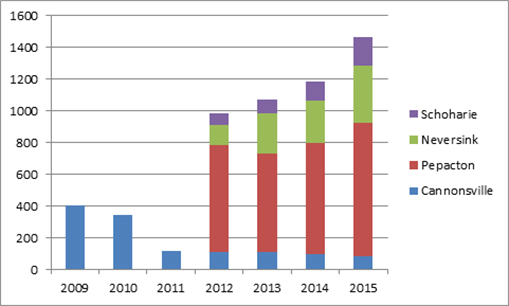FOR IMMEDIATE RELEASE 16-48 May 26, 2016 Contact: deppressoffice@dep.nyc.gov (845) 334-7868 Department of Environmental Protection Announces Start of 2016 Recreational Boating Season in the CatskillsThousands of boaters from the watershed, New York City and beyond have paddled or sailed on reservoirs since the program began in 2012New boat launch to open at Pepacton Reservoir to expand and improve accessThe New York City Department of Environmental Protection (DEP) today announced that the 2016 recreational boating program will begin Friday at sunrise on four water supply reservoirs in the Catskills. The popular outdoor program, now in its fifth year, has attracted thousands of boaters to paddle or sail on the Cannonsville, Pepacton, Neversink and Schoharie reservoirs. This year also marks the opening of a new boat launch site at Miller Hollow, along Pepacton Reservoir, which will improve access for visitors coming from Downsville, Roscoe and other points to the south and west of the reservoir. That boat launch will also open on Friday. “The recreational boating program has been a remarkable success over the past five years,” DEP Acting Commissioner Steven Lawitts said. “DEP and its partners at the Catskill Watershed Corporation have continued to attract more outdoor enthusiasts through expanded rental opportunities, new boat launch sites, and targeted marketing efforts. We hope watershed residents and visitors will join us again in 2016 to paddle on the reservoirs and enjoy the scenic beauty of the Catskills.” “It’s great to see more and more people getting out on the water,” Catskill Watershed Corporation Executive Director Alan Rosa said. “We are happy to support this program that is healthy for paddlers and sailors and for our economy, too.” The recreational boating program led to 1,463 visits in 2015, an all-time record and the largest year-over-year increase in participation since it began in 2012. That increase was largely driven by the success of the rental program, which allows visitors to rent pre-cleaned and registered kayaks and canoes from 10 launch sites along the reservoirs. The rental program, administered by the Catskill Watershed Corporation (CWC), attracted 683 boaters in 2015, nearly double the visits from the previous year. Rental boats are stored on 30 racks alongside the reservoirs to promote easier access for visitors to the region and those who don’t own a boat. CWC funded the storage racks, along with annual brochures to market the program and sanitary facilities at the launch sites. In addition to the rentals, DEP issued 780 tags to boaters in 2015, including 511 kayaks, 226 canoes, 40 rowboats, two sailboats and one scull. Including boat rentals, Pepacton Reservoir attracted 840 boating visits, the most of any reservoir, followed by 359 at Neversink, 180 at Schoharie, and 84 at Cannonsville. Roughly 19 percent of the recreational boating tags issued by DEP went to residents of the five watershed counties, including Delaware, Greene, Schoharie, Sullivan, and Ulster. About 11 percent of the tags were issued to residents of New York City or Long Island. Visitors from five states also received tags, including Connecticut, Maryland, Pennsylvania, New Jersey and Vermont. Recreational Boating Program Visits
Note: 2009-2011 include a pilot program at Cannonsville Reservoir only Recreational boating season in the Catskills begins the Friday before Memorial Day and lasts until Columbus Day, from dawn till dusk. Boaters must have a DEP access permit that is available free of charge on DEP’s website by visiting nyc.gov/dep/accesspermit. All boats used on the reservoirs must also be steam cleaned by one of the 13 DEP-certified steam cleaning vendors conveniently located across the watershed. A list of those vendors is available on the DEP website at nyc.gov/dep/recreation. Additional information about the recreational boating program can also be found at www.VisitTheCatskills.com/paddling. Steam cleaning helps protect against invasive plants, animals, and microorganisms that can harm water quality and fisheries. If a recreational boat is taken off reservoir property, it must be steam cleaned again before it can reenter the reservoir. Throughout the course of the recreational boating program, DEP has continuously tested water quality to ensure that none of the recreational activities has an adverse effect on New York City’s drinking water supply. Since 2003, DEP has significantly expanded the amount of city properties within the watershed that are open for recreation. There are now more than 130,000 acres of land and water open for fishing, hiking and other low-impact recreation. Of that, more than half of the land is located in public access areas that are open to recreation without the need for a DEP access permit. DEP manages New York City’s water supply, providing more than one billion gallons of high quality water each day to more than 9.5 million New Yorkers. This includes more than 70 upstate communities and institutions in Ulster, Orange, Putnam and Westchester counties who consume an average of 110 million total gallons of drinking water daily from New York City’s water supply system. This water comes from the Catskill, Delaware, and Croton watersheds that extend more than 125 miles from the City, and the system comprises 19 reservoirs, three controlled lakes, and numerous tunnels and aqueducts. DEP has nearly 6,000 employees, including almost 1,000 scientists, engineers, surveyors, watershed maintainers and other professionals in the upstate watershed. In addition to its $68 million payroll and $157 million in annual taxes paid in upstate counties, DEP has invested more than $1.7 billion in watershed protection programs—including partnership organizations such as the Catskill Watershed Corporation and the Watershed Agricultural Council—that support sustainable farming practices, environmentally sensitive economic development, and local economic opportunity. In addition, DEP has a robust capital program with over $14 billion in investments planned over the next 10 years that will create up to 3,000 construction-related jobs per year. For more information, visit nyc.gov/dep, like us on Facebook, or follow us on Twitter. | ||
